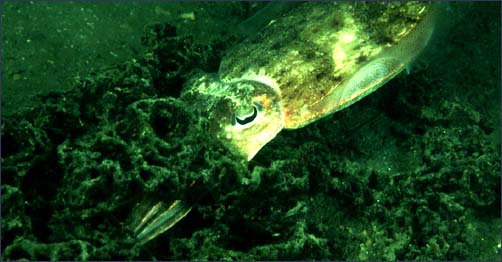
|
Vol.22 Ago Bay: Encouter in the Sea of Pearl |

|
Vol.22 Ago Bay: Encouter in the Sea of Pearl |

|
|
|
A female golden cuttlefish was spawning by stretching her tentacles to the kagomenori seaweed. |
|
|
Ago Bay is the largest bay on the Shima Peninsula, which is on the southeastern part of Mie Prefecture. In this area, the movement of the earth's crust has been active since ancient times. The ground was forced up and was eroded and created mountains and ravines. The earth sunk again to form a bay. The bay therefore was formed out of the ragged coastline known as a Rias coast. The rugged bay is protected from the waves of the open sea. For cultured pearls which needs floating rafts on the sea surface, this bay is ideal.
It is also in this bay, that Mr. Kokichi Mikimoto created the worlds first cultured pearl in 1905. In this quiet bay are many inlets and small islands as though it were a miniature garden. The view of the sunsets here is especially famous for its beauty. It is at the heart of the Ise Shima National Park. Ten or so years ago, I had the opportunity to dive into Ago Bay for a TV report. Since the expensive cultured pearls are grown here in Ago Bay, scuba diving is usually out of the question. It is like asking to be let in to a banks vault. For divers, it is a sea that is unapproachably far. As I dived from a small boat in this rare opportunity, and approached the rafts, there were many baskets containing pearl oysters hanging down from the surface and swaying gently. Receiving sun light streaming through the green water of the bay, the pearls were growing in a timeless atmosphere that stood apart from the limited time span of humans. It was last year that I got another chance to dive into this sea which is strictly guarded as though it were under martial law. The reason was the production of a pictorial of the marine creatures in Ago Bay. The marine laboratory of Mie University, located on Zaga Island inside the bay, assisted my dive. In the bay, anyone whose background is unclear is viewed with suspicion, as a stranger in a bank vault might be. When I dived into the sea from the pier of the laboratory, there was a sandy mud bottom where seaweed grew here and there. As I was searching the sea bottom while shooting small fish such as gobies, suddenly, two golden eyes appeared between the seaweed. It was a golden cuttlefish 14 to 15 centimeters in length. When I approached the cuttlefish, she changed her body color and became cautious but did not try to run away. She seemed to make up her mind and came closer to me. The golden cuttlefish then began to spawn on the seaweed, called kagomenori, which was right in front of my eyes. When she finished spawning the eggs, she returned slowly to the sandy sea bottom and after digging the sand with her tentacles, she returned to the kagomenori to spawn again. She kept repeating this act. The egg was about 1.5cm and covered with sand. It was well camouflaged. The previous behavior that I saw of the mother digging the sand with her tentacles was to cover the egg with sand. By doing this, the egg looked like plain sand on the seaweed, and even if found may be difficult to eat with its protection of sand. I have seen the eggs of the golden cuttlefish in Tokyo Bay as well, but the shape of the egg and the method of spawning were different. Is this due to the regional differences in ecology or is the cuttlefish of a different kind? With these thoughts in mind, I continued to observe her. The golden cuttlefish spawned ten or so eggs in roughly two hours. She continued to spawn without flinching from the huge creature that was me, who she had never met before. I felt that her courage and resoluteness could not be explained by the mere term instinct. Perhaps it is a wildness that we have lost. Men feel the grandeur of nature in the pearls smooth brilliance but I am not so refined a person. Instead, I was moved by the raw courage of the female cuttlefish. It was encouraging to know that we can still find wonderful stories off a tiny part of the Japanese coastline if we only listen and look hard enough.
|
|
|